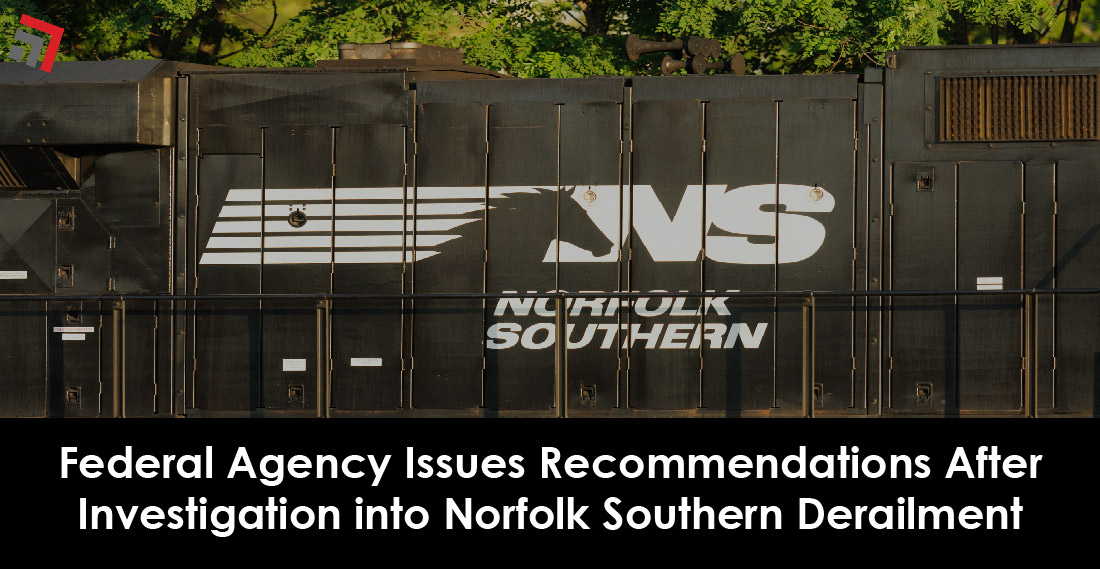On Tuesday, the National Transportation Safety Board (NTSB) released a report detailing cause, critique, and recommendations surrounding the February 2023 derailment of a Norfolk Southern (NS) train laden with toxic materials in East Palestine, Ohio.
Following the accident, which occurred late evening on Feb. 3 of last year, NTSB has undergone a full investigation over the derailment, including hearings where NS (Class I railroad) officials were questioned on their safety protocols and handling of the situation.
For background on last year’s derailment: Investigative Hearings Held Over NS Train Derailment
Nearly a year and a half removed from the night of the derailment, NTSB’s latest report outlines new recommendations from the federal agency as well as insight into what caused the accident in the first place.
NTSB: Wheel bearing failure caused derailment
NTSB concluded that the NS train derailed as a result of a wheel bearing failure on a hopper car. The compromised bearing, while on fire leading up to the accident, did not trigger alarms at two hot bearing detectors the train passed prior to its wreck near East Palestine. It was not until moments before the derailment that the wayside detector alert sounded.
Recommendations for freight rail
Altogether, NTSB issued 31 recommendations, covering concerns over safety, communication, and industry cooperation. These recommendations appear as broad aspirations—not solely directed at NS, but all stakeholders of the railroad industry.
Safety recommendations
- Improvement of detecting wheel bearing failures
- Provide first responders with necessary training and hazardous materials information
- Implement tougher tank car standards
- Tigthen operational restrictions on trains carrying hazardous materials
Communication recommendations
- Improvement of communication among railroads, derailment contractors, chemical manufacturers, and first responders, especially as it relates to emergency decision-making during derailments
Within its communication recommendations, NTSB referenced the NS derailment and criticized the decision to vent and burn tank cars filled with flammable hazardous materials. The federal agency emphasized that the release of toxic fumes from the burn was a major contributor to the severity of the accident’s aftermath, which deteriorated the air quality, soil, and drinking water of nearby communities to an indeterminate degree.
NTSB slammed the decision to vent and burn as a product of poor communication, confusing and misleading information, and disregard for evidence that did not support releasing the contents of the tank cars. Board members with the agency called the decision-making process flawed.
NS has been critical of NTSB’s characterization of the decision. The railroad explained the decision to vent and burn as a precaution to avoid a feared chemical reaction, the likes of which would have led to an explosion of hazardous materials and shrapnel.
However, through its investigation, NTSB asserts it found no evidence that such a reaction was going to occur, thus deeming the vent and burn operation unnecessary.
Industry cooperation recommendations
NTSB also included recommendations pointed at all railroads as well as regulators, shippers, chemical manufacturers, and first responders.
In the regulatory realm, the federal agency has asked the Federal Railroad Administration, a government agency under the U.S. DOT, to gather more data on hot bearing detectors to frame minimum requirements for temperature and alarm thresholds and spacing between wayside detectors. At this time, wayside detectors are not regulated, however railroads have vowed to reduce spacing within 15 miles on average.
NTSB also recommends:
- The Association of American Railroads (trade group representing Class I railroads) to create a database of bearing failure to help regulators further identify and address future risks
- The phase-out of the model of tank car (DOT-111) which carried hazardous material in the NS derailment
- The Pipeline and Hazardous Materials Shipping Administration, federal agency, to broaden designation of high-hazard flammable trains and accelerate the deadline for phasing out DOT-111 tank cars (currently
- NS to review and revise its policies to ensure information is immediately available to first responders, especially when needed to make emergency response decisions
- Chemical manufacturers and shippers to ensure their knowledge and understanding of hazardous materials is shared with the proper authorities, especially in the event of an emergency response
Click here for the summary of NTSB’s full report.
Service Perspective: Public scrutiny overshadows freight rail advantages
The February 2023 NS derailment was a disaster that resulted in more than just the loss of cargo of shippers. Local wildlife and communities in and around East Palestine continue to contend with the uncertain impacts that a hazardous release of toxic chemicals carries over time. There is no doubt that when an event like this occurs, the fact that it was a possibility in the first place warrants reflection from across industry stakeholders, especially NS. Public scrutiny over the highly-publicized accident should be understood by railroad leaders, while recommendations towards minimizing accidents should be welcomed by the industry.
However, stepping back from the disaster, its devastating effects on East Palestine, a separate discussion exists. One where public criticism in response to the accident has bled over to a general assessment of the mode’s service record. In other words, rather than strictly focusing critiques over safety and accountability, some shippers, in respects to their needs to move freight, have used the NS derailment as another reason to denounce freight rail as a service option.
When compared to trucking, its surface transportation counterpart, freight rail is by far the safer, and cheaper, option of moving cargo across the U.S. It is not practical for every shipper, but Commerce Express Inc.’s Strategic Development Manager Owen Campbell has listed the following criteria. If a shipper marks these boxes, freight rail is unquestionably an added benefit to their supply chain.
- Shippers with lanes between two large cities that cover regional and/or cross-country distances (examples: Los Angeles to Chicago; Los Angeles to Dallas; Oakland to Nashville)
- Shippers and receivers whose pickup and drop off points are close (within 100 miles) to a rail ramp (located in port cities and select inland cities)
- Shippers with cargo that can book several days in advance and acknowledge the longer transit times of rail versus trucking (example: Transit between Los Angeles to Chicago ramps can take anywhere from ten to 20 days, while a long-haul trucking option typically takes half a week)
The last part about transit time may appear as a caveat to using rail, however if a shipper’s supply chain is predictable and well-managed, the extended transit will be of no concern. Again, if a shipper can check off these boxes, the cost savings between long-haul trucking and freight rail are palpable. Can freight rail benefit your company’s supply chain?




Recent Comments